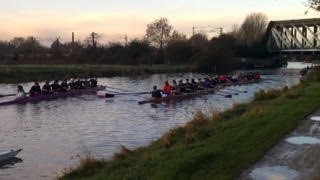The Cambridge Rowing Tank project was begun in early 2016 and has been entirely funded by philanthropic giving. The project team visited tanks at Oxford University, Radley College, Molesey, Thames Rowing Club and Barn Elms as well as Dreher, the supplier of the tank unit, in Boston on the East coast of the US.
Construction began in June 2017 and completed at the end of 2017. The tank has been installed at Downing College Boat House, on a newly built mezzanine floor, above the boat bays. The two tanks are 50′ long and hold around 20 tonnes of water.
The time lapse video below shows the installation process.
The tank unit is a US product made by The Durham Boat Company in Boston, a subsidiary of Dreher. It is the same as the one installed recently at Molesey, one of the UK’s top clubs, in London. The Dreher website outlines the key features and benefits of an athlete powered, static water tank.
Why should you use the Cambridge Rowing Tank?
The tank saves you time. You learn faster, better, more safely and conveniently.
Indoor tanks are used extensively throughout the US and are becoming more common in the UK. They are a great way to speed up the development of good rowing technique in novices, and better rowing technique in more experienced and elite rowers. A tank has a particular benefit in Cambridge where the large number of rowers on a small river at limited times of the day leads to large congestion problems. Did you know that Oxford has had a tank for over 25 years!
Why put up with this…


At novice level, the benefits of a tank are:
1. Beginners can be introduced to rowing in a safe, controlled and stable environment. When they progress to the river, they will already know how to row and will have practiced safety actions and manoeuvres such as backing down, holding up, spinning etc;
2. A rowing tank is a material improvement on the more common simulator, the rowing machine (ergometer), since the full stroke is performed with blades out to the side of the tank rather than just pulling a chain in and out as on an ergo. The size and weight of the blade become familiar and ‘catching’ the water can be practiced;
3. Coaching can quite literally be hands-on as coaches can walk up and down the middle of the tank to correct the posture/positioning/stroke pattern of each rower; and
4. Coxing commands can be taught and practiced in a safe setting.
Many of these benefits carry over at higher levels of skill development.
Additional benefits at a more senior level include:
1. Rowers can see themselves on two HD screens fed by a series of 8 cameras positioned around and above the tank;
2. The stable platform allows for the rowing stroke to be broken down to a very precise degree, and coaching in this way can be individualized without worrying about steering, other crews or needing to accommodate the remainder of a crew; and
3. Coaches can easily take close video footage of the whole crew or individual members without the distraction of riding a bike down the towpath.
Other benefits:
1. Training and coaching can be carried out at all times of the day, unrestricted by regulations regarding river usage during hours of darkness or peak hours for college rowing. This will encourage participation and retention rates at novice level, and lessen the chronic river congestion;
2. Crews can have outings and be coached when the river is closed for flooding, ice, high winds or angling competitions; and
3. The coach can focus solely on watching and communicating with the crew, rather than riding a bike and having to shout across the river to coach while keeping the crew safe and progressing through traffic on the river. The coaching experience can be much more intensive as a result.
The tank will improve the overall rowing experience for your athletes and help you broaden participation and increase retention rates.